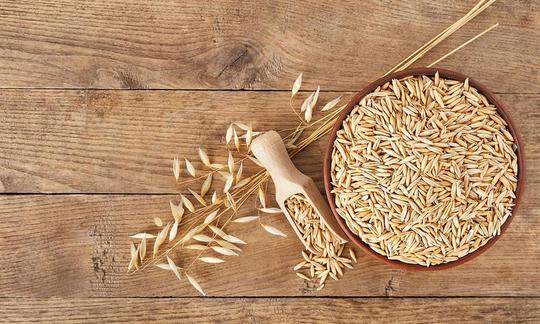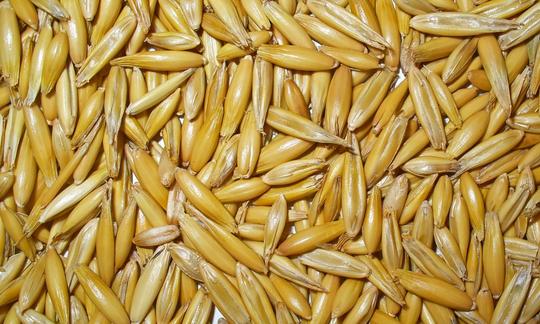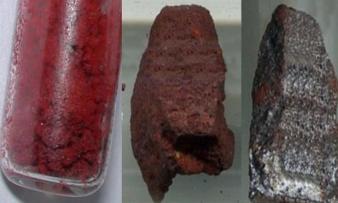Table of contents
Seed oats or True oats ( Avena sativa ) are a nutrient-rich grain that is not only used as a whole grain. But note: this hulled grain is usually not raw , and often not even the whole grain! The nutty taste intensifies when heated.
Use in the kitchen
A wide variety of products are made from seed oats, such as oat flakes , oat bran, oat flour, cereals, oat drinks or oat cream . The use of oat flour in bread is limited, as this grain does not contain gluten. However, oat biscuits or cookies can be baked very well with it. Whisky made from oats is popular in some regions and oat beer has been known since the Middle Ages.
Oats can be cooked like rice after soaking them in water overnight. Real oats taste great cooked as a side dish, mixed with vegetables, as a "risotto" or as an ingredient in soups and stews. Oat casseroles, fritters or patties can be made very well with potatoes . Oats enrich your morning muesli as flakes (oat porridge).
The combination with a lot of fat, salt or sugar can also make oat dishes unhealthy. Therefore, make sure that your diet is low in sugar, fat and salt. Try our recipes with oats or oat products. However, oats have a poor ratio between the essential omega-6 and omega-3 fatty acids (22:1) - even in a larger amount than, for example, wheat, spelt, etc.
Vegan recipe for raw oat salad
Ingredients and preparation (for 3 people): Cook 100 g of oats (raw) for about 30 minutes ( soak naked oats overnight). Mix half a red onion , a bell pepper and about a quarter of a cucumber with the cooked oats. Season to taste with apple cider vinegar (or rapeseed oil ), a little salt, herbs andpepper . A little chili gives the oat salad an exciting spiciness. The salad tastes good both lukewarm and cold.
You can also find vegan recipes with oats under the note: "Recipes that have the most of this ingredient".
| Not only vegans or vegetarians should read this: Vegans often eat unhealthily. Avoidable nutritional mistakes . |
Purchasing - Storage
Due to the longer shelf life, the manufacturer almost always heats seed oats (grain and flakes). Be clear about whether you want to buy normal seed oats or naked oats . Naked oats ( Avena nuda ) are only loosely covered with husks and no dehusking process is necessary. Naked oats are a little harder to get hold of because they are more susceptible to fungal diseases and produce smaller yields. The husks of common oats ( Avena sativa ) hold very well, so they are peeled using a complex process. Depending on the peeling process 1 , it is easier if the oats are pre-treated with heat. Read more about the possible processes under the heading "Industrial production". This "drying" is carried out on both conventional and organic products (organic). Not only does it destroy the germination capacity of the oats 2 , but it also leads to the loss of valuable amino acids (e.g. lysine ).
If you want to buy unheated, raw and germinating oats, look for the label "naked oats" or "sprouted grain oats" when buying. The Donath mill confirmed to us that their "sprouted grain oats" are their own variety of the Avena nuda species. You will hardly find this quality in normal supermarkets such as Coop , Migros , Denner , Volg , Spar , Aldi , Lidl , Rewe , Edeka , Hofer , Billa , DM etc. But health food stores, organic shops (such as Denn's Biomarkt , Alnatura ) or unpackaged stores usually have naked oats in their range. They often label them as "germinating oats" or "raw food quality oats". In online shops you can of course find organically produced seed and naked oats. If possible, give preference to regional oats and organic quality.
"Unhulled" can also mean seed oats, but then they still contain the husks and are therefore inedible. Packaging that only says "oats" almost always contains dehulled seed oats, and these are often not raw.
Oats are generally available all year round . The availability of oats varies depending on the size of the store, catchment area, etc. If you are interested, click on our recorded food prices for the DA-CH countries (above under the ingredient image). There you will find current prices from various supermarkets and their price development.
Found in the wild
There are several species that are called wild oats: The dead oat ( Avena sativa ssp. sterilis ) is native to southwest Asia. The wild oat ( Avena sativa ssp. fatua ) is also known as wind oat and can cross-breed due to its close relationship with cultivated oats. This bothers many seed producers in agriculture because wild oats are a weed and have a significant impact on yields. It is believed that wild oats evolved from seed oats and they grow throughout Europe and Asia. 3
Storage tips
Like all grains, oats should be stored in a dry, dark place. In a dry room, you can store oats in a paper bag (often coated with foil on the inside). But watch out for unwanted insects (eg moths). If you are unsure about the humidity in the room, it is advisable to transfer the oats to an airtight container. This way, naked oats will last for several years.
Ingredients - Nutritional values - Calories
Oats have a nutritional value of 389 kcal/100g and are very nutrient-rich compared to other types of grain commonly found in Central Europe. Oats contain a lot of protein (17%) and fat (6.9%). The protein they contain (13%) is largely made up of essential amino acids. 4 The fat content is three times as high as in wheat and more than twice as high as in spelt . Oat protein is nutritionally more important than that of wheat. 5
In terms of minerals, real oats contain high amounts of manganese . 100 g contain 4.9 mg, which is 246% of the daily requirement. Pecans (raw) have a similar amount and raw pine nuts have a very high amount of manganese at 8.8 mg (100 g cover 440% of the daily requirement). 4
The element phosphorus is also present in large quantities at 523 mg/100g (75% of the daily requirement). Wheat grains have a comparable value and unpeeled hemp seeds have an extremely high value at 1650 mg/100g. 4 Since phosphorus is present in many processed products as phosphoric acid, we have enough of it.
Thiamine (vitamin B 1 ) is present in a significant amount at 0.76 mg/100g and covers around 70% of the daily requirement. Sesame has a similar content of the B vitamin and rice flakes cover 136% of the daily requirement at 1.5 mg/100g. 4
In addition to magnesium , folate (folic acid), potassium and zinc , oats also contain 4.9 mg of iron . 100 g cover 34% of the daily requirement. To increase the absorption of iron from a plant source, it is advisable to supplement with a source of vitamin C. Ascorbic acid enables a reduction of Fe 3+ to Fe 2+ and thus the blood cells can absorb the iron well. 6
Oats also contain phytosterols, alkaloids, avenanthramides (secondary plant substances), silicic acid and linoleic acid. β-glucan, a soluble dietary fiber, is contained in oats at 2-6%. 7
The complete ingredients of oats, the coverage of the daily requirement and comparison values with other ingredients can be found in our nutrient tables. In the article Nutrients explained you will get a detailed insight into the topic.
Effects on health
Oats are considered a healthy and inexpensive food and are a superfood not only for athletes. The fiber, proteins (amino acids) and polyphenols they contain help to strengthen the immune system and regulate inflammatory reactions. 8
β-glucans (beta-glucans) are unbranched polysaccharides and are found in oats as insoluble and soluble dietary fiber. These beta-glucans are found primarily in the endosperm and in the cell wall of the aleurone layer. Beta-glucans increase the viscosity of the intestine and shorten the transit time of the intestinal contents, which has a positive effect on weight loss. This also influences blood sugar levels and thus reduces the insulinemic reaction in diabetes. The effects on blood fat concentration and the associated cholesterol levels (for LDL and HDL) should also be mentioned here. 7
Scientific studies show that a high fiber content in the diet contributes to disease prevention. β-glucan from oats helps against high blood pressure, lipid metabolism disorders, coronary heart disease and is said to reduce the risk of cancer and support the quality of chemotherapy. 9 Oat bran can demonstrably lower blood cholesterol levels. 10 But wheat bran, which mainly contains insoluble fiber, also has a positive effect on blood fat levels. 11
The long-lasting feeling of satiety prevents cravings. If you include wholegrain oat flakes in your daily diet (e.g. 50-100 g), you can achieve weight loss success over a longer period of time (at least 1 year). 12
The phytic acid contained in many types of grain often has a negative reputation. Phytic acid binds minerals such as iron, zinc, calcium and magnesium in the stomach and intestines. These are then no longer fully available to us. By delaying the breakdown of starch in the body, phytic acid also regulates blood sugar levels. According to Wikipedia, oats have between 0.42 and 1.16 g phytic acid/100 g. 8 Read more about this in the article Phytic acid or phytate and soaking or sprouting .
Dangers - Intolerances - Side effects
Do oats contain gluten? In principle, oats are considered gluten-free. However, this is a question of definition, because it depends not only on the individual sensitivity of the patient but also on the variety. 13 However, commercially available seed oats are usually contaminated with other gluten-containing grains such as wheat, barley, spelt or rye. Conventional oat products are therefore unsuitable for people with celiac disease. Gluten-free oats in particular ("gf oats") have a gluten content of less than 20 ppm and bear the "gluten-free symbol", a crossed-out ear of corn in a circle. People with celiac disease can also cope well with small amounts of oats under certain circumstances. This has been shown by various studies. For many allergy sufferers and those affected by celiac disease, only gliadin is intolerant, but not all other gluten (e.g. avenalin in oats). Therefore, when buying oats, you should definitely look for oat products that are labelled as "gluten-free". Some people cannot tolerate gluten-free oats either, so it is important to try this out in consultation with a doctor and find out. 14
Use as a recognized medicinal plant
Oat fruits (Avenae fructus) and oat herb (Herba avenae) are classified in the HMPC as herbal medicinal products ("traditional use"). Commission E attributes a positive effect to oat straw (Stramentum avenae) when applied externally to inflammatory and seborrhoeic skin diseases (itching). 20
Ecological footprint - animal welfare
In Switzerland, oat imports in 2002 were >70%, which means that the country's internal footprint in the field of arable farming is very low at 2% compared to wheat at 21%. The wheat import share in the statistics available to us is just over 40%. The most important importing countries are France, Germany and Italy. 17
The ecological CO 2 footprint for the production of 1 kg of oats is 0.57 CO 2 eq/kg and thus lower than that of wheat (0.59 CO 2 eq/kg). 25 The amount of water required to produce 1 kg of oats is relatively high at 1788 liters and is similar to that for the production of rice (1673 liters). 21 A study compared the environmental impacts of organic and conventional oat production in western Canada and could not identify a clear favorite for one cultivation method. Although organic farming does not use synthetic pesticides and fertilizers, these savings are offset by the use of organic fertilizers and their transport and the emissions produced. 22 Nevertheless, it can be stated that the pesticides used in conventional agriculture have a strong negative impact on important pollinators such as wild bees and honey bees. For example, the nesting frequency of wild bees, the growth of bumblebee colonies, 23 or the overwintering rate of honey and wild bees decreases after exposure to pesticides or pesticide-contaminated plants. 24
Since the use of oats is often associated with oat milk , it is worth mentioning that the CO 2 emissions for this are significantly lower than for rice milk , for example. The cultivation of oats also requires significantly less water than for almonds or rice . Land use is slightly higher for oats than for soy , almonds or rice. 18
Worldwide occurrence - cultivation
Oats were cultivated in Central Europe in the Bronze Age, with the earliest evidence of cultivation being in Switzerland. It was not until the 19th century that potatoes and wheat replaced oats as a staple food. Today, Russia, Canada, Australia and Poland are the main producers. 15
Cultivation -
Harvest As an annual summer crop, oats prefer a temperate climate with high rainfall rates. They have low soil requirements. They are also known as a "health crop" because many grain pests do not reproduce in them. If a germination attempt with naked oats does not work straight away, this does not mean that their germination capacity is impaired. Oats germinate in the dark and in the cold and require soil temperatures of around 4-5 °C for good germination. 16 They form their grains in a panicle with many branches, not in an ear like wheat.
Both summer oats and winter oats can be grown. Summer oats are planted in early spring, from late February to March. Winter oats are planted in mid-September to October and remain in the field over the winter. The harvest season is from late July to early August, as soon as the moisture content of the grain is only 14%. 16
Industrial production
Spelt oats are only edible for humans after they have been hulled. After the golden yellow oat kernels have been harvested, the mill separates the coarse dirt, foreign grains, seeds and straw particles, and the kernels are sieved and sorted by size. The oats are then "kilned" (dried) at around 90-100 °C. 1 To do this, the kernels are passed through hot pipes. The kilning process deactivates the fat-splitting enzymes and reduces the moisture content. This significantly reduces the risk of the kernels or other products (flakes) going rancid. For retailers, the better storage capacity and longer shelf life are also major advantages of this treatment. In addition, the heat treatment partially breaks down the oat starch, which makes the oats more digestible for human digestion. But the oats are no longer raw afterwards. The taste also changes: the kilning process makes the oats taste nuttier. 19 Many manufacturers believe that oats taste bitter when unheated. However, this argument refers more to naked oats, which generally contain more bitter substances.
With underrunner hulling, the heating process ("drying") is followed by size sorting and then dehusking of the oat grains. No prior drying is necessary for dehusking in a centrifugal huller. The oat grains are spun onto an impact ring, which separates the husks from the grain. The oat kernels remain with all their components such as endosperm, outer layers and germ. The lighter husks are sucked off using a blower. Only then does the drying process begin. 1 Before further processing, e.g. rolling to make oat flakes, the oats must be steamed with hot steam to improve elasticity. The pressed grains are then dried again. 1,19
Further information
Avena sativa is the Latin name for seed oats. This plant species from the oat genus ( Avena ) belongs to the sweet grass family. It is grown as a grain and is colloquially known simply as "oats". The approximately 25 Avena species are distributed from northwest Africa and Spain through the Mediterranean to the Middle East.
Today, oats are mainly cultivated for animal feed. Seed oats (yellow or black oats) are ideal as feed grain for horses, cattle and poultry. They are less suitable as pig feed due to their high crude fiber content. However, as people's consumption habits have changed in recent years, oats are increasingly being integrated into the human diet again.
Sand oats or rough oats ( Avena strigosa ) have not been cultivated for their grains for more than 100 years. They also produced yields on light, sandy soils where it was too dry for seed oats. Unfortunately, sand oats or bicorn oats have not survived in Switzerland. 3
Alternative names
For the sake of simplicity, we always write Avena sativa as seed oats or real oats. However, it is also known as cultivated oats, spelt oats or edible oats. Avena nuda is naked oats or sprouted grain oats.
The English name for oats is oats.
Other applications
Varieties such as yellow oats or black oats are used as feed, mainly for horses and foals; in rolled form these are called rolled oats.










Comments